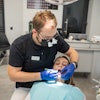
The U.S. Food and Drug Administration (FDA) continues to warn practitioners that respiratory depression may occur in patients taking the drugs gabapentin or pregabalin, especially patients who are also predisposed to respiratory depression due to their concomitant use of other respiratory depressants, such as opioid analgesics, and other drugs that depress the central nervous system (CNS), such as benzodiazepines. Patients with underlying respiratory disease (such as chronic obstructive pulmonary disease) and elderly patients are also at increased risk.
This is of particular concern to dentistry, since the use of opioid analgesics in the management of severe odontogenic pain, the use of benzodiazepines for anxiolysis and conscious sedation, and the use of gabapentin in the management of trigeminal neuralgia are well established.
 Tom Viola, RPh.
Tom Viola, RPh.The FDA based its warning on its review of the results of two randomized, double-blind, placebo-controlled clinical trials; three observational studies; and several studies in animals.
Gabapentin and pregabalin are FDA-approved for a variety of conditions, including seizures, nerve pain, fibromyalgia, and restless legs syndrome. Gabapentin was first approved in 1993 and pregabalin was first approved in 2004. Gabapentin is marketed under the brand names Neurontin and Gralise. Gabapentin enacarbil (a prodrug) is marketed under the brand name Horizant. Pregabalin is marketed under the brand names Lyrica and Lyrica CR.
The use of these drugs, often referred to as gabapentinoids, has been growing, not only for medical use but also for misuse and abuse, especially in combination with opioids.
Lyrica (pregabalin) is listed as a schedule V controlled substance because it has a lower potential for abuse but may lead to some physical or psychological dependence.
Gabapentin is not currently scheduled by the U.S. Drug Enforcement Administration (DEA) as a controlled substance. However, several states, such as Kentucky and Michigan, have classified gabapentin as a schedule V controlled substance. Other states, such as Ohio and Minnesota, have not gone so far as to classify gabapentin as a controlled substance, but they have taken steps to monitor its use through state-level prescription drug monitoring programs (PDMPs). Thus, gabapentin may or may not appear in a search of a PDMP, based on the individual state-imposed restrictions.
There is less evidence supporting the risk of serious breathing difficulties in healthy individuals taking gabapentinoids alone. However, one clinical trial reviewed by the FDA did show that using pregabalin alone and using it with an opioid pain reliever can depress breathing function. Another clinical trial showed that gabapentin alone increased pauses in breathing during sleep.
In addition, three observational studies at one academic medical center showed a relationship between gabapentinoids given before surgery and respiratory depression occurring after different kinds of surgeries. Finally, published animal studies suggest that gabapentinoids have an independent dose-dependent depressive effect on respiration and can augment the respiratory depression caused by opioids.
While the prevailing approach for optimizing pain control, especially in dentistry, is focused on incorporating one or more nonopioid analgesics with opioid analgesics, pairing an opioid with any CNS depressant (such as gabapentinoids, benzodiazepines, sedating antidepressants, sedating antipsychotics, antihistamines, etc.) may increase the risk of respiratory depression.
The FDA's evaluation of respiratory depression with gabapentinoids flies in the face of the widely held belief that gabapentinoids lack drug interactions and have wide therapeutic indices. Clearly, studies demonstrate that these drugs can behave in an additive way to potentiate respiratory depression and CNS depression.
Tom Viola, RPh, is a clinical educator, professional speaker, and published author in the areas of oral pharmacology and local anesthesia. For more information on this and other pharmacology topics, as well as a list of dates and locations where you can attend his latest seminars, visit his website at www.tomviola.com.
The comments and observations expressed herein do not necessarily reflect the opinions of DrBicuspid.com, nor should they be construed as an endorsement or admonishment of any particular idea, vendor, or organization.



















